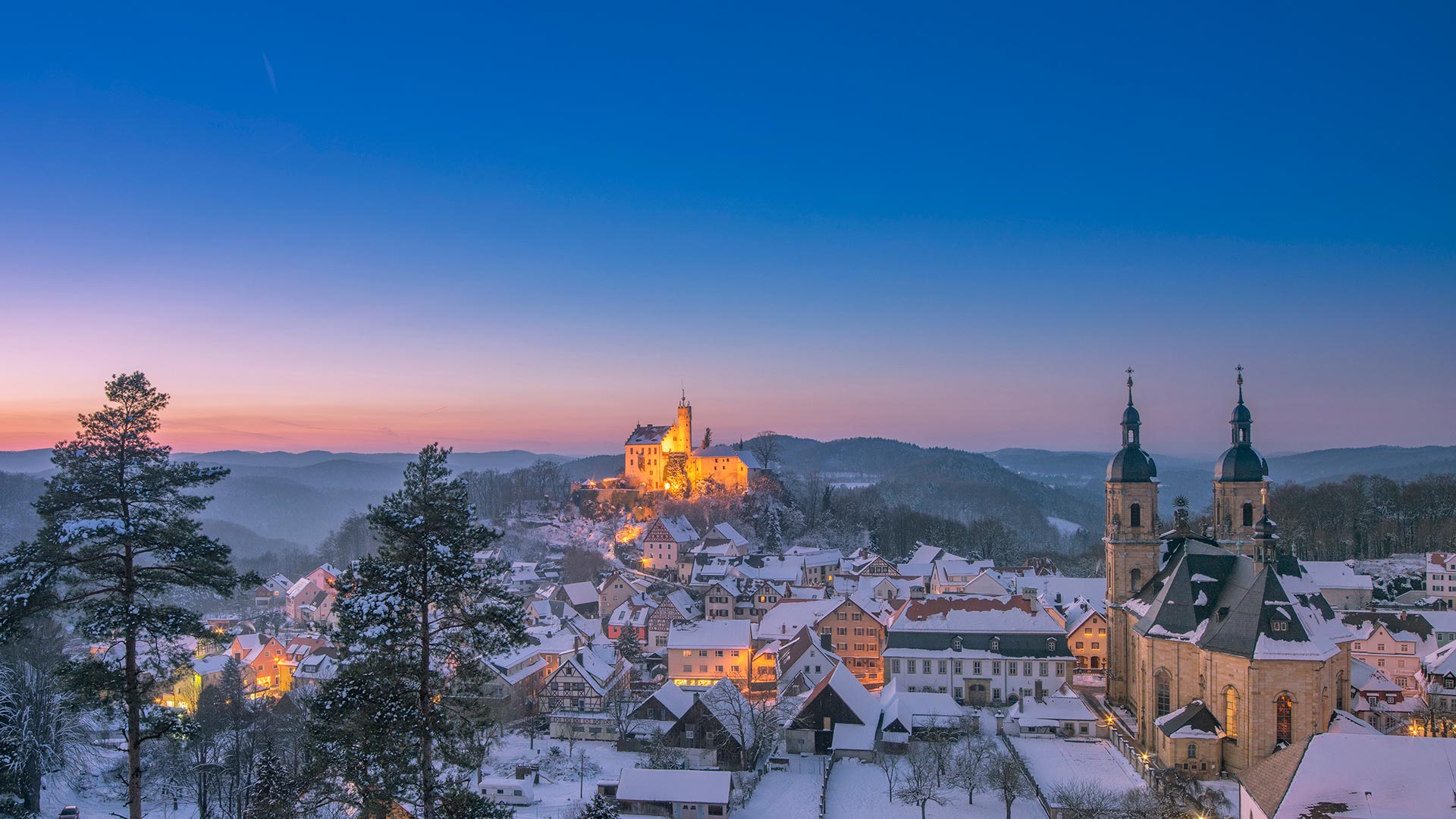汝拉山中的Chateau de Joux堡,法国 Château de Joux in the Jura mountains of France (© Ivoha/Alamy)
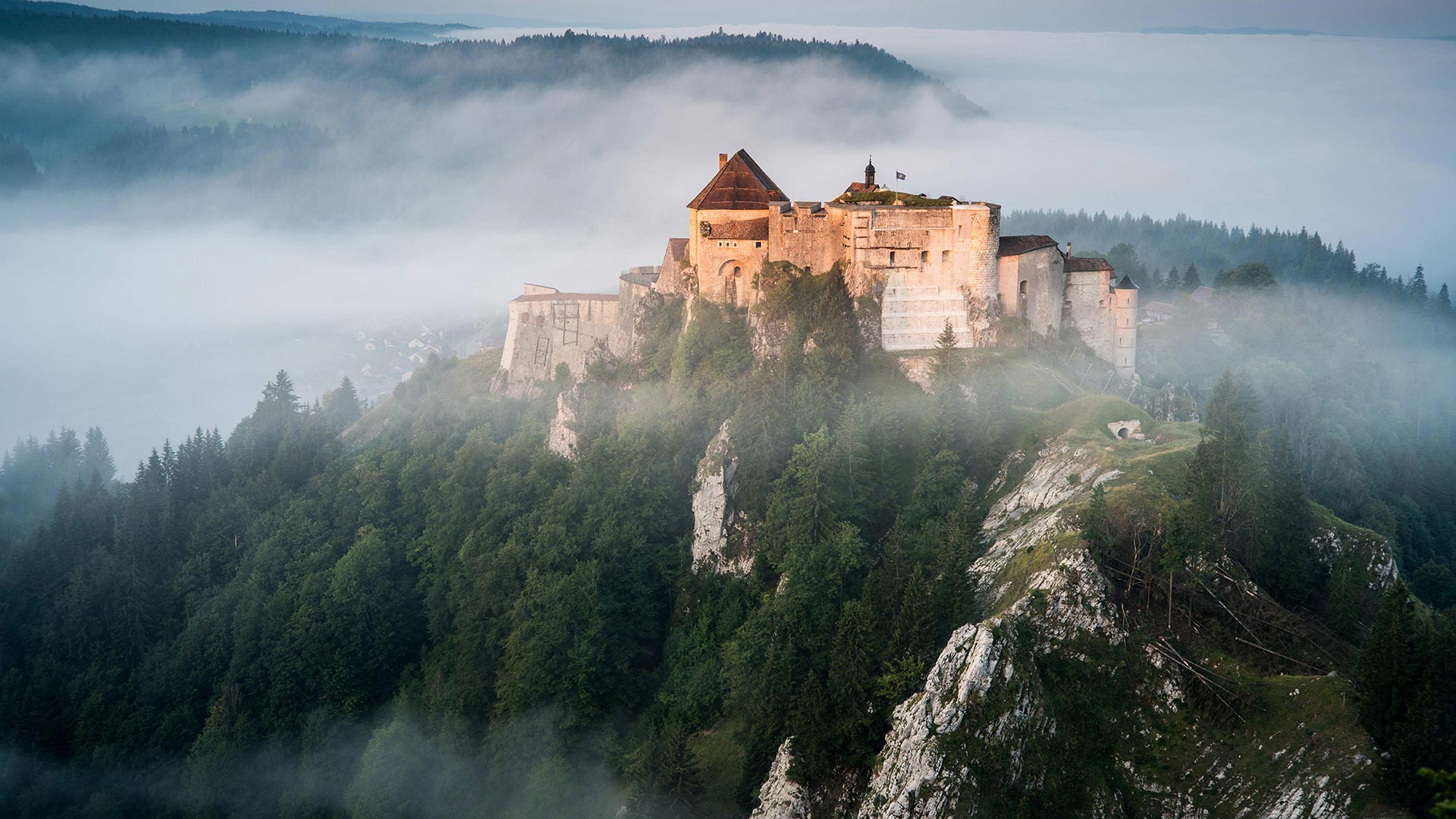
汝拉山中的Chateau de Joux堡,法国 Château de Joux in the Jura mountains of France (© Ivoha/Alamy)
Military art
Overlooking the valley linking France to Switzerland (the Cluse de Pontarlier), Joux castle – with its keep, towers, drawbridges, surrounding walls and fort – offers fantastic evidence of the way fortifications have developed over the years. Built in the 11th century, then modified by Vauban in the 17th century, people will discover 10 centuries of history there.
军事艺术
俯瞰连接法国和瑞士的山谷(Cluse de Pontarlier),Joux castle及其要塞、塔楼、吊桥、围墙和堡垒为多年来防御工事的发展提供了极好的证据。建于11世纪,17世纪被沃邦修缮,人们将在那里发现10个世纪的历史。
霍恩施万高城堡, 巴伐利亚, 德国 Hohenschwangau Castle, Bavaria, Germany (© Mespilia/Shutterstock)
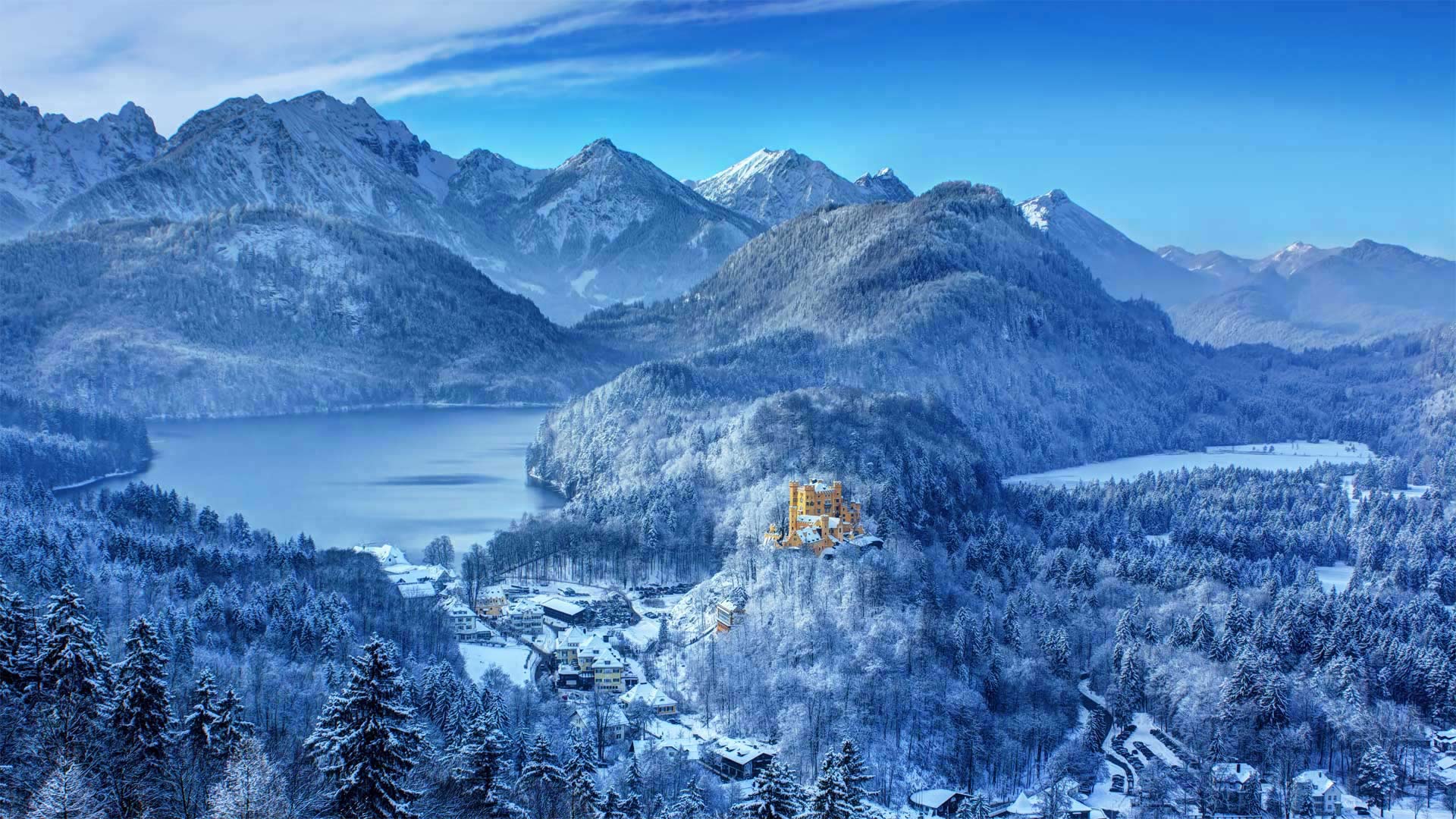
霍恩施万高城堡, 巴伐利亚, 德国 Hohenschwangau Castle, Bavaria, Germany (© Mespilia/Shutterstock)
An Alpine fairytale castle
During a walking tour in the spring of 1829, Crown Prince (and future King) Maximilian II of Bavaria fell in love with these forested mountains and Alpine lakes, so three years later he bought the dilapidated remains of a 12th-century castle overlooking the village of Hohenschwangau. The yellow neo-Gothic castle that Maximilian built to replace the earlier ruins became the summer home and hunting retreat for the king, his wife Marie of Prussia, and their two sons, Ludwig and Otto. Hohenschwangau Castle became a kind of fantasy palace, particularly for the two young princes, who spent their time traipsing through the forest, reciting poetry, and staging scenes from the Romantic operas of Richard Wagner.
After the death of King Maximilian in 1864, Ludwig ascended to the throne and moved into his father's rooms in Hohenschwangau castle. He ordered that stars be painted onto the bedroom's ceiling and had them illuminated by hidden oil lamps. Ludwig and his successors made few other modifications, so most of the rest of the castle remains unchanged even today—the 19th-century interiors contain period furniture, and preserved on the walls are more than 90 frescoes depicting heroic German folklore and the medieval legends of Wagner's operas.
阿尔卑斯山童话城堡
在1829年春天的一次徒步旅行中,巴伐利亚的王储(和未来国王)马克西米利安二世爱上了这些森林覆盖的山脉和阿尔卑斯山湖泊,因此三年后,他买下了一座12世纪的城堡的破旧遗骸,俯瞰着霍恩施旺高村。马克西米利安为取代早期遗址而建造的黄色新哥特式城堡成为国王、普鲁士的妻子玛丽和他们的两个儿子路德维希和奥托的夏季家园和狩猎撤退地。霍恩施万高城堡成了一座梦幻宫殿,尤其是对两位年轻的王子来说,他们花时间在森林中穿山,背诵诗歌,并上演理查德·瓦格纳的浪漫歌剧场景。
1864年马克西米利安国王去世后,路德维希登上王位,搬进了他父亲在霍恩施旺高城堡的房间。他命令把星星涂在卧室的天花板上,用隐藏的油灯照亮它们。路德维希和他的继任者几乎没有进行其他修改,因此城堡的其他大部分仍然保持不变——19世纪的室内装着时期的家具,墙壁上保存着90多幅壁画,描绘了德国英雄的民间传说和瓦格纳歌剧的中世纪传说。
远眺格斯韦因斯泰因村和格斯韦因斯泰因城堡 (© Juergen Sack/Getty Images)
艾琳多南堡,苏格兰 Eilean Donan Castle in Scotland (© CBW/Alamy)
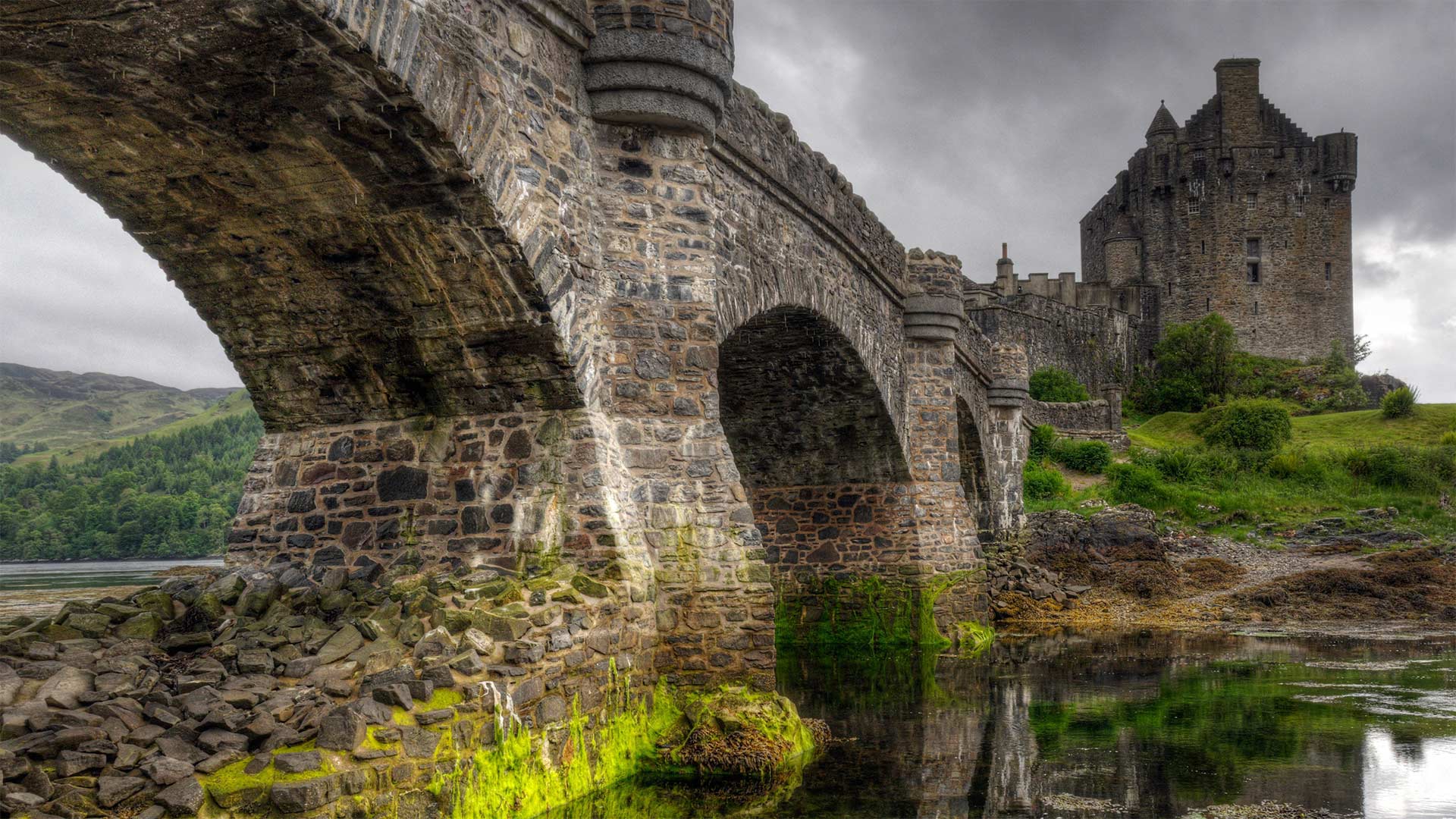
艾琳多南堡,苏格兰 Eilean Donan Castle in Scotland (© CBW/Alamy)
A water loch-ed castle
Located on a small island where three sea lochs meet in northwestern Scotland, the current Eilean Donan Castle is just the latest incarnation of several monastic cells and Scottish clan strongholds that have occupied the small island since the 7th century. The first fortified castle was built in the 13th century to defend against invading Vikings who occupied much of Scotland at the time. An iconic symbol of Scotland, from the 14th-18th centuries, the castle was mostly held by the Mackenzies and defended by the Macraes, both storied clans of the Scottish Highlands. The castle was destroyed in 1719 by the invading British Royal Navy during the Jacobite Uprising, but was rebuilt along its earlier design in the early 20th century by Lt. Colonel John Macrae-Gilstrap.
科夫堡,英国多塞特 Corfe Castle, Dorset, England (© Ross Hoddinott/Minden Pictures)
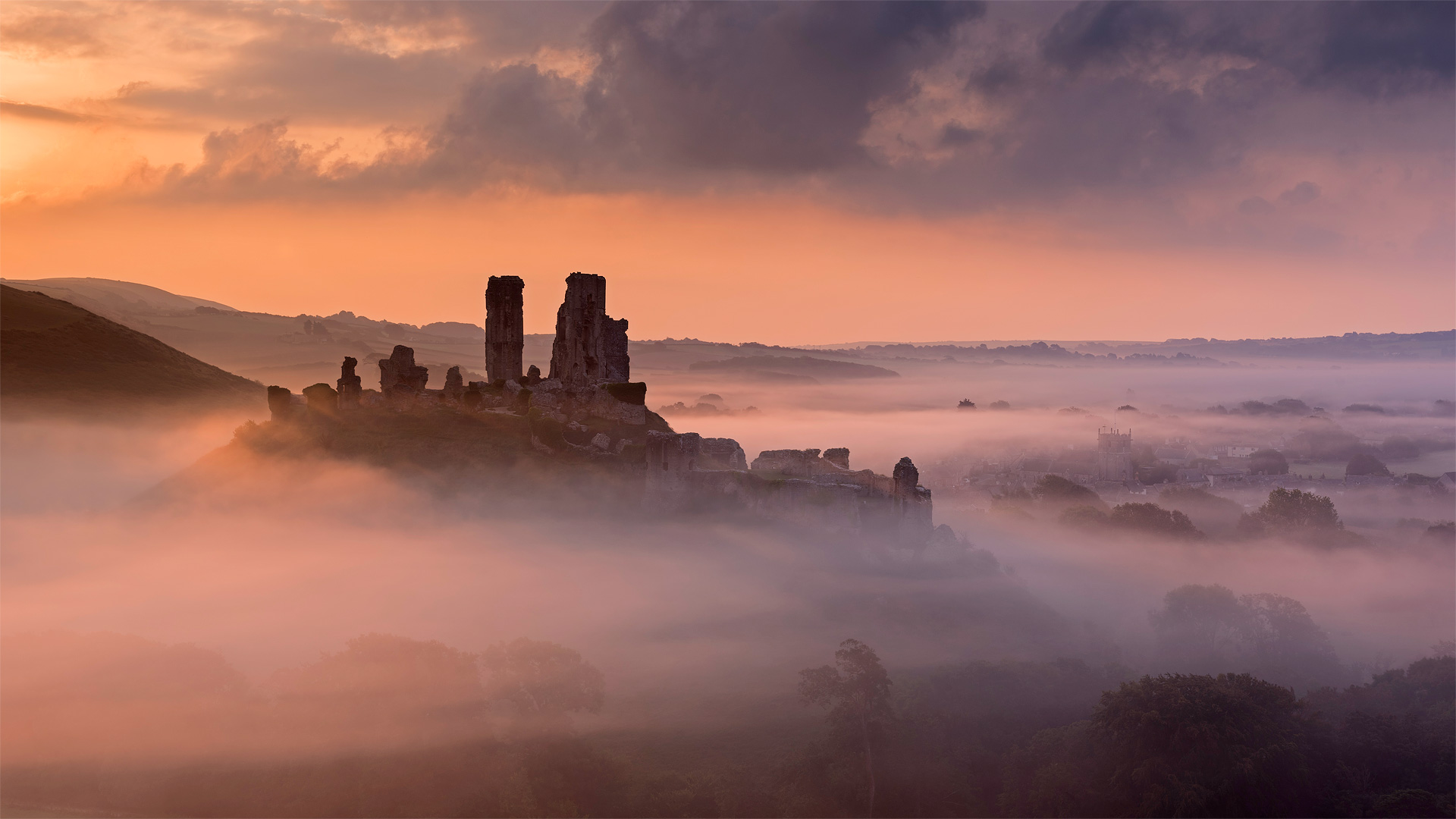
科夫堡,英国多塞特 Corfe Castle, Dorset, England (© Ross Hoddinott/Minden Pictures)
Creepy Corfe Castle
Spying the crooked silhouette of Corfe Castle above the rolling, foggy hills of Dorset, you might not guess at the ruin's former palatial beauty—you'll more likely sense its long history of intrigue, and maybe feel a chill down your spine.
Corfe's tale begins with a betrayal. Rumor has it this mound is where the teenage King Edward the Martyr was assassinated, likely by his half-brother and successor Æthelred the Unready, in 978—a century before the original stone structure was built. The castle became a favorite of 13th-century ruler King John—whose luxurious renovations hid a feared dungeon where the calculating monarch starved numerous prisoners. In the mid-1600s English Civil War, noblewoman Mary Bankes—wife of the castle's new lord, who was off fighting the war—doggedly defended it against antiroyalist forces in a 3-year siege. But Mary was given up by members of her entourage and captured, and the castle was toppled into the craggy heap you see now—another betrayal to end its story.
Nowadays the remains of Corfe Castle are preserved as a Scheduled Ancient Monument by the UK—but that status might not be all that's protecting the site. Reports of children's sobs echoing through the air, unexplained flickering lights, and—most notoriously—the headless apparition of a white-clad woman have some believing specters of a millennium past still haunt the ruin.
堡垒山上的珀纳里城堡,法加拉斯山,罗马尼亚 Poenari Castle on Mount Cetatea, Făgăraș Mountains, Romania (© porojnicu/Getty Images)

堡垒山上的珀纳里城堡,法加拉斯山,罗马尼亚 Poenari Castle on Mount Cetatea, Făgăraș Mountains, Romania (© porojnicu/Getty Images)
A castle fit for a count
Peeking out above the trees in the Făgăraș Mountains of Romania is Poenari Castle, an ancient structure whose reputation is steeped in history and legend. In the 15th century this castle was occupied by the notoriously ruthless ruler Vlad III, aka Vlad the Impaler, aka Vlad Dracula. Vlad wasn't a vampire, but he was known for treating his enemies with particular cruelty. His bloody resistance to Ottoman encroachment would make him a national hero and the subject of much folklore, some of it gruesome. These tales are likely what inspired author Bram Stoker to name his fictional vampire Count Dracula.
Poenari Castle continued to be used following Vlad's death in 1476 but was abandoned decades later. It fell into ruin over the centuries, as earthquakes and landslides sent parts of the building down the cliff and into the Argeș River below. Visiting the ruins today requires determination and stamina—it's a 1,480-step climb to the citadel walls, unless you're able to take the form of a bat and fly to the top.
Restormel城堡上空的秋雾,英国康沃尔 Autumn mist above Restormel Castle in Cornwall, England (© Robert Harding/Alamy)

Restormel城堡上空的秋雾,英国康沃尔 Autumn mist above Restormel Castle in Cornwall, England (© Robert Harding/Alamy)
The circular castle of Cornwall
Many generations watched fog roll over this countryside long before the bellicose Norman visitors who built this fortress got the chance. The peninsula of Cornwall has been populated since the Mesolithic period 10,000 years ago, and is one of the traditional Celtic nations—areas of the British Isles and France where the Celts' culture survived Roman, Norman, and other outside influences despite repeated attempts at incursion.
Restormel Castle is one of the best-preserved keeps of its era in the UK, and also stands apart for its rare rotund shape. Built by the conquering Normans in the wake of their 1066 invasion of Britain, it was fortified as a perfect stone circle a hundred years later. Soon it was renovated into a luxurious palace with rudimentary plumbing and coveted hunting grounds. But after centuries of off-and-on use, it fell into disrepair after the English Civil War ended in 1651. It was acquired by the British government in the early 20th century. Open to the public, Restormel is now managed by the English Heritage charity trust.
洛阿雷城堡,西班牙韦斯卡 Castle of Loarre, in Hoya de Huesca, Aragon, Spain (© Sebastian Wasek/Alamy)
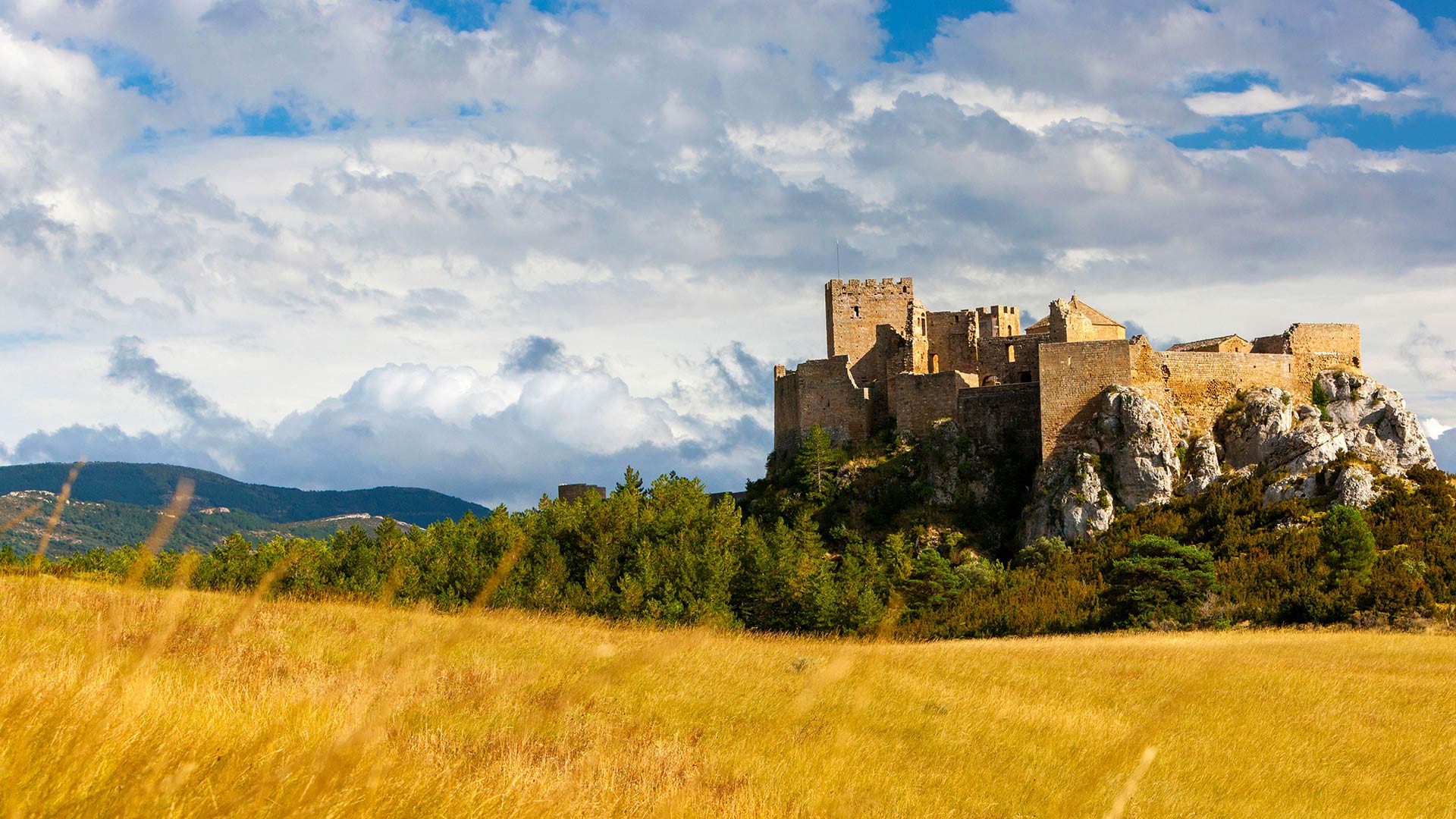
洛阿雷城堡,西班牙韦斯卡 Castle of Loarre, in Hoya de Huesca, Aragon, Spain (© Sebastian Wasek/Alamy)
Floating in time
The castle of Loarre we show you today is a Romanesque jewel that has remained suspended in time for almost a thousand years near the Spanish side of Pyrenees mountain range. It was built by king of Navarre Sancho ‘the Great’ in the 11th century and there’s no other equal or better preserved fortress of that style in all of Europe.
Once finished, in 1070, it became an unbreakable bastion that played a crucial role in the “Reconquest” of the Aragonese territories occupied during the Arab invasion three centuries before, since it was in the battle frontline and mounted on a rocky hill that made it impregnable. From there Sancho’s grandson troops took back the city of Huesca and managed to advance near Zaragoza. And once the battleground had moved further in the south, the castle became a monastery, was expanded two times and surrounded finally by an outer wall to protect the population settled at its feet.
Today, Loarre is a protected national monument that can also be visited. And actually 100,000 people do it every year. If you like epic cinema, you will surely recognize this place, as it has served as stage in several films, like for instance 2005’s “Kingdom of Heaven” directed by Ridley Scott.
罗卡马杜尔,法国 Rocamadour, France (© Rrrainbow/Getty Images)
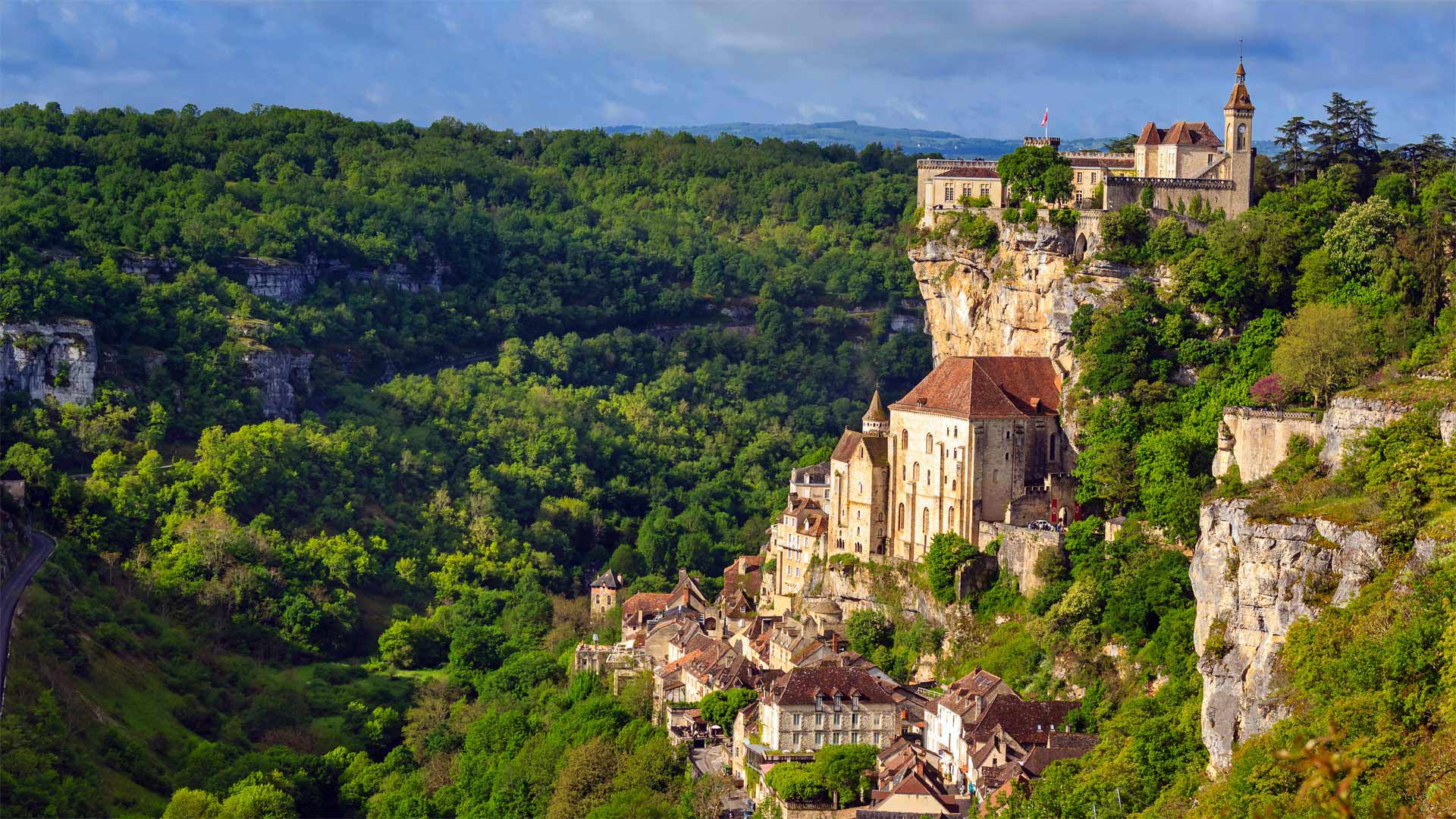
罗卡马杜尔,法国 Rocamadour, France (© Rrrainbow/Getty Images)
A city, a cliff, a canyon…and cheese
Gazing down the lush Alzou river valley at the vertically-oriented village of Rocamadour, you won't be surprised some regard the medieval French town as a holy site: Its beauty alone is mystical. The gorges of southwestern France are home to numerous striking historic hamlets built along and atop their steep edges. But Rocamadour is special as a stop for thousands of pilgrims on the Way of Saint James, a UNESCO-recognized traditional route through France and Spain that still draws journeyers both pious and secular. The town's cliff-top sanctuary and the black-painted Madonna statue within have been purported to have healing powers. If you're drawn to more earthly sources of good health, though, Rocamadour also lends its name to a delicious, locally crafted goat cheese.
As we end on that cheesy note, why not test your dairy IQ with today's quiz?
伊夫城堡,法国马赛 Château d'If in Marseille, France (© Boris Stroujko/Shutterstock)
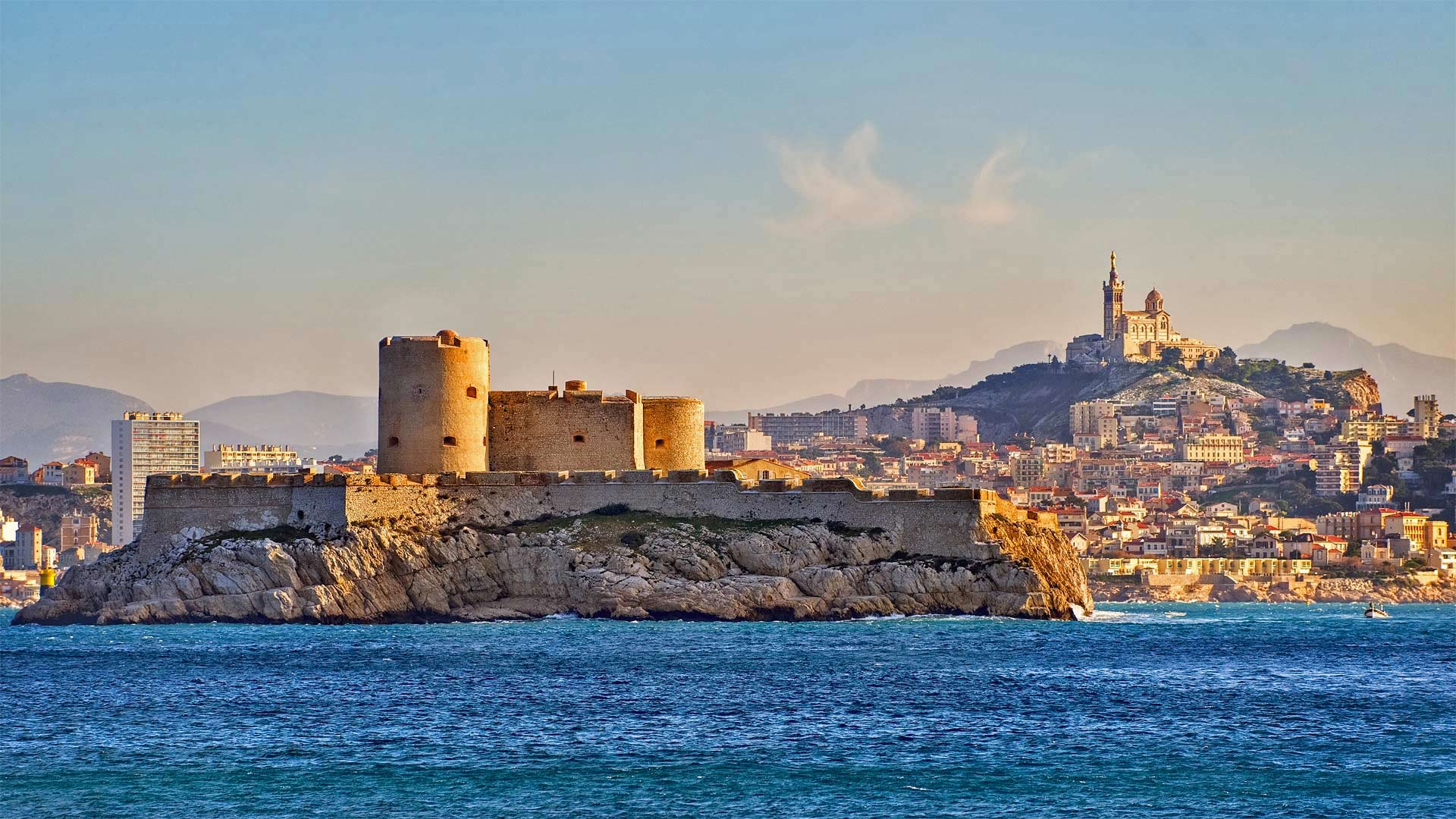
伊夫城堡,法国马赛 Château d'If in Marseille, France (© Boris Stroujko/Shutterstock)
A prison fit for a count
Château d'If, off the coast of Marseille, France, was built beginning in 1524 as a fortress by King Francis I because of the tiny island's steep cliffs and strategic location. While the 'château' never gained notoriety defending the ancient port (since it was never attacked), it did become famous as a prison. Surrounded by treacherous currents—like Alcatraz in San Francisco—it gained a reputation starting in the late 16th century as a dumping ground for powerful political and religious prisoners. As far as official records go, none of the prisoners condemned there ever escaped.
However, there is one famous tale of an escape from the château by one Edmond Dantes, the titular hero of the 1844 Alexander Dumas novel 'The Count of Monte Cristo.' And though he is a work of fiction, you can visit Edmond Dantes' cell on the lower level of the prison. The nearly perfectly preserved castle is just a short ferry ride from the docks of the old port of Marseille.
